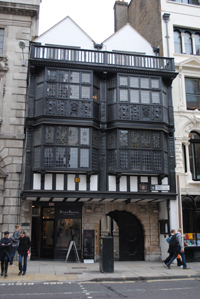Before Madame Tussaud arrived in London, there was Mrs Salmon and her famous waxworks, one of several such establishments in London.
 First sited at the Sign of the Golden Ball in St Martin’s Le Grand – where it filled six rooms – in 1711, the display was relocated to the north side of Fleet Street where it remained until 1795 when it moved across the road to number 17 Fleet Street, now housing Prince Henry’s Room (pictured, room takes its name from Prince Henry, eldest son of the king, who died at the age of 18 and was apparently the inspiration for an inn which previously occupied the building called The Prince’s Arms).
First sited at the Sign of the Golden Ball in St Martin’s Le Grand – where it filled six rooms – in 1711, the display was relocated to the north side of Fleet Street where it remained until 1795 when it moved across the road to number 17 Fleet Street, now housing Prince Henry’s Room (pictured, room takes its name from Prince Henry, eldest son of the king, who died at the age of 18 and was apparently the inspiration for an inn which previously occupied the building called The Prince’s Arms).
The waxworks were apparently originally run by Mr Salmon – there are references to him being a “famous waxwork man” – but his wife, Mrs Salmon, continued it alone after his death in 1718 until her own death, variously said to have been in 1760 or as late as 1812. At some point after his death, Mrs Salmon is said to have remarried, to a Mr Steers.
While some accounts say the waxworks – which, according to the City of London website remained at the site until 1816 – were taken over by a Chancery Lane surgeon named Clarke after Mrs Salmon’s death (and by his wife after his death), it is also suggested that at some point they moved to Water Lane in east London where they were ruined by thieves.
Whatever its fate, it’s generally accepted that the famous waxworks were visited by the likes of James Boswell and artist William Hogarth. They were also mentioned by author Charles Dickens in David Copperfield.
For more of London’s past, see Philip Davies’ Lost London 1870-1945.
Correction: Elmes died on August 16th – not in September!
Please see The Gentleman’s Magazine of 1798. Elmes Foster died on September 16th. He disposed of the waxworks in Fleet Street before his death. According to the short obituary, Elmes appears to have been married to the granddaughter of Mrs. Salmon! He had 4 known children: William, Elizabeth, Elmes and Jemima, all baptised at St. Paul’s.
Mrs. Salmon’s great-granddaughter, Elizabeth Foster, married engraver William Harrison in London before he removed with his family to Philadelphia, where he had been called to engrave America’s first bank notes following the Revolutionary War. William died in Philadelphia on October 18th, 1803.
William is mentioned in connection with the British East India Company and Alexander Dalrymple in a publication “Return to the East India Company” at the Oxford U. Press: “…during the fifteen years between his appointment in 1779 and the emigration of his chief engraver William Harrison to Philadelphia in 1794, Dalrymple …” And in fact, Harrison is found to have lettered most of Dalrymple’s maps between 1780 and 1793.
Most of the Harrison children had been born in London and the sons were schooled in the art of engraving by their father in Philadelphia. Son Charles Peter fathered a large clan himself and moved with his wife, Elizabeth Porter, to Brooklyn.
Charles’ son Gabriel was an author, actor and artist. Biographies of Gabriel (for example in The National Cyclopaedia of American Biography Volume 5, 1894, page 218. New York: James T White & Company), claimed he was a direct descendant of John “Longitude” Harrison. Gabriel was also one of America’s early daguerreotypists whose work can be found in the Metropolitan Museum of Art in New York.